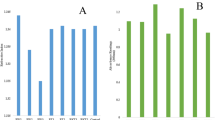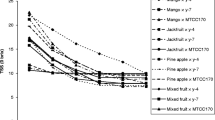Abstract
This research describes on-farm-inoculated cocoa bean fermentation with two selected strains of high aroma-producing Saccharomyces cerevisiae isolated from wine fermentation and their effects on volatile profile of resulted raw cocoa material and sensory characteristics of chocolates produced. Both strains produced suitably flavour-active esters, aldehydes, ketones and pyrazines in raw cocoa. Inoculation of S. cerevisiae at 0.5 g kg−1 significantly improved the volatile profile of raw cocoa beans and enabled production of chocolate with enhanced intense fresh fruits and floral notes. Chocolate produced thereof presented better overall quality attributed whatever the fermentation time in comparison to the chocolate issued from spontaneous fermentation. Our results suggested the ways of using selected enhanced yeasts as S. cerevisiae for on-farm implementation of bean fermentation as promising alternative possibilities to improve the cocoa fermentation process, desirable flavourful raw cocoa material and high-aroma-quality chocolates produced.








Similar content being viewed by others
References
Afoakwa EO, Budu AS, Brown HM, Takrama JF, Ansah EO (2014) Effect of roasting conditions on the browning index on appearance properties of pulp pre-conditioned and fermented cocoa (Theobroma cacao) beans. J Nutr Health Food Sci 2:1–5
Afoakwa EO, Quao J, Takrama J, Budu AS, Saalia FK (2013) Chemical composition and physical quality characteristics of Ghanaian cocoa beans as affected by pulp pre-conditioning and fermentation. J Food Sci Technol 50:1097–1105
Thompson SS, Miller KB, Lopez AS (2001) Cocoa and coffee. In: Doyle MP, Beuchat MP, Montville TJ (eds) Food microbiology. American Society for Microbiology, USA, fundamentals
Schwan RF, Wheals AE (2004) The microbiology of cocoa fermentation and its role in chocolate quality. Crit Rev Food Sci Nutr 44:205–221
Aprotosoaie AC, Luca SV, Miron A (2016) Flavor chemistry of cocoa and cocoa products – an overview. Compr Rev Food Sci Food Saf 15:73–91
Afoakwa EO, Paterson A, Fowler M, Ryan A (2008) Flavor formation and character in cocoa and chocolate: a critical review. Crit Rev Food Sci Nutr 48:840–857
Hashim P, Selamat J, Muhammad SKS, Ali A (1998) Effect of mass and turning time on free amino acid, peptide-N, sugar and pyrazine concentration during cocoa fermentation. J Sci Food Agric 78:543–550
De Vuyst L, Lefeber T, Papalexandratou Z, Camu N (2010) The functional role of lactic acid bacteria in cocoa bean fermentation. In: Mozzi F, Raya RR, Vignolo GM (eds) Biotechnology of lactic acid bacteria novel applications. Wiley, Hoboken
Crafack M, Mikkelsen MB, Saerens S, Knudsen M, Blennow A, Lowor S, Takrama J, Swiegers JH, Petersen GB, Heimdal H, Nielsen DS (2013) Influencing cocoa flavor using Pichia kluyveri and Kluyveromyces marxianus in a defined mixed starter culture for cocoa fermentation. Int J Food Microbiol 167:103–116
Meersman E, Steensels J, Mathawan M, Wittocx PJ, Saels V, Struyf N, Bernaert H, Vrancken G, Verstrepen KJ (2013) Detailed analysis of the microbial population in Malaysian spontaneous cocoa pulp fermentations reveals a core and variable microbiota. PLoS One. https://doi.org/10.1371/journal.pone.0081559
Ho VTT, Zhao J, Fleet G (2014) Yeasts are essential for cocoa bean fermentation. Int J Food Microbiol 174:72–87
Leal GA, Gomes LH, Efraim P, Almeida TFC, Figueira A (2008) Fermentation of cacao (Theobroma cacao L.) seeds with a hybrid Kluyveromyces marxianus strain improved product quality attributes. Federation Eur Microbiol Soc Yeast Res 8:788–798
Lefeber T, Gobert W, Vrancken G, Camu N, De Vuyst L (2011) Dynamics and species diversity of communities of lactic acid bacteria and acetic acid bacteria during spontaneous cocoa bean fermentation in vessels. Food Microbiol 28:457–464
Hamdouche Y, Guehi T, Durand N, Kedjebo KBD, Montet D, Meile JC (2015) Dynamics of microbial ecology during cocoa fermentation and drying: towards the identification of molecular markers. Food Control 48:117–122
Koné KM, Guéhi TS, Durand N, Ban-Koffi L, Berthiot L, Fontana TA, Brou K, Boulanger R, Montet D (2016) Contribution of predominant yeasts to the occurrence of aroma compounds during cocoa bean fermentation. Food Res Int 89:910–917
Batista NN, Ramos CL, Ribeiro DD, Pinheiro MAC, Schwan RF (2015) Dynamic behavior of Saccharomyces cerevisiae, Pichia kluyveri and Hanseniaspora uvarum during spontaneous and inoculated cocoa fermentations and their effect on sensory characteristics of chocolate. LWT Food Sci Technol 63:221–227
Arana-Sánchez A, Segura-García LE, Kirchmayr M, Orozco-Ávila I, Lugo-Cervantes E, Gschaedler-Mathis A (2015) Identification of predominant yeasts associated with artisan Mexican cocoa fermentations using culture-dependent and culture-independent approaches. World J Microbiol Biotechnol 31:359–369
Ostovar K, Keeney PG (1973) Isolation and characterization of microorganisms involved in the fermentation of Trinidad’s cacao beans’. J Food Sci 38(4):611–617
Sandhya MVS, Yallappa BS, Varadaraj MC, Puranaik J, Rao JL, Janardhan P, Murthy PS (2016) Inoculum of the starter consortia and interactive metabolic process in enhancing quality of cocoa bean (Theobroma cacao) fermentation. Food Sci Technol 65:731–738
Samagaci L, Ouattara H, Niamké S, Lemaire M (2016) Pichia kudriazevii and Candida nitrativorans are the most well-adapted and relevant yeast species fermenting cocoa in Agneby-Tiassa, a local Ivorian cocoa producing region. Food Res Int 89:773–780
Chetschik I, Kneubühl M, Chatelain K, Schlüter A, Bernath K, Hühn T (2017) Investigations on the aroma of cocoa Pulp (Theobroma cacao L.) and its influence on the odor of fermented cocoa beans. J Agric Food Chem 2018, 66:2467–2472
Pereira GVM, Neto DPC, Medeiros ABP, Soccol VT, Neto E, Woiciechowski AL, Soccol CR (2016) Potential of lactic acid bacteria to improve the fermentation and quality of coffee during on-farm processing. Int J Food Sci Technol 51:1689–1695
Lefeber T, Papalexandratou Z, Gobert W, Camu N, De Vuyst L (2012) On-farm implementation of a starter culture for improved cocoa bean fermentation and its influence on the flavour of chocolates produced thereof. Food Microbiol. https://doi.org/10.1016/j.fm.2011.12.021
Schwan RF (1998) Cocoa fermentations conducted with a defined microbial cocktail inoculum. Appl Environ Microbiol 64(4):1477–1483
Ramos CL, Dias DR, Miguel MGCP, Schwan RF (2014) Impact of different cocoa hybrids (Theobroma cacao L.) and S. cerevisiae UFLA CA1 inoculation on microbial communities and volatile compounds of cocoa fermentation. Food Res Int 64:908–918
Lagunes Gálvez S, Loiseau G, Paredes JL, Barel M, Guiraud J-P (2007) Study on the microflora and biochemistry of cocoa fermentation in the Dominican Republic. Int J Food Microbiol 114(1):124–130
Guehi TS, Zahouli IB, Ban-Koffi L, Fae MA, Nemlin JG (2010) Performance of different drying methods and their effects on the chemical quality attributes of raw cocoa material. Int J Food Sci Technol 45:1564–1571
Papalexandratou Z, Camu N, Falony G, De Vuyst L (2011) Comparison of the bacterial species diversity of spontaneous cocoa bean fermentations carried out at selected farms in Ivory Coast and Brazil. Food Microbiol 28:964–973
Nielsen DS, Honholt S, Tano-Debrah K, Jespersen L (2005) Yeast populations associated with Ghanaian cocoa fermentations analyzed using denaturing gradient gel electrophoresis (DGGE). Yeast 22:271–284
Rodriguez-Campos J, Escalona-Buendía HB, Contreras-Ramos SM, OrozcoAvila I, Jaramillo-Flores E, Lugo-Cervantes E (2012) Effect of fermentation time and drying temperature on volatile compounds in cocoa. Food Chem 132:277–288
Frauendorfer F, Schieberle P (2006) Identification of the key aroma compounds in cocoa powder based on molecular sensory correlations. J Agric Food Chem 54:5521–5529
Kongor JE, Hinneh M, Walle DV, Afoakwa EO, Boeckx P, Dewettinck K (2016) Factors influencing quality variation in cocoa (Theobroma cacao) bean flavour profile—a review. Food Res Int 82:44–52
Beckett ST (2009) Conching. In: Beckett ST (ed) Industrial chocolate manufacture and use. Wiley, Chichester
Ducki S, Miralles-Garcia J, Zumbé A, Tornero A, Storey DM (2008) Evaluation of solid-phase micro-extraction coupled to gas chromatography–mass spectrometry for the headspace analysis of volatile compounds in cocoa products. Talanta 74:1166–1174
Jinap S, Rosli W, Russly AR, Nordin LM (1998) Effect of roasting time and temperature on volatile component profiles during nib roasting of cocoa beans (Theobroma cacao). J Sci Food Agric 77:441–448
Aculey PC, Snitkjaer P, Owusu M, Bassompiere M, Takrama J, Nørgaard L, Petersen MA, Nielsen DS (2010) Ghanaian cocoa bean fermentation characterized by spectroscopic and chromatographic methods and chemometrics. J Food Sci. https://doi.org/10.1111/j.1750-3841.2010.01710.x
Serra-Bonvehí J (2005) Investigation of aromatic compounds in roasted cocoa powder. Eur Food Res Technol 221:19–29
Jinap S, Thien J, Yap TN (1994) Effect of drying on acidity and volatile fatty acids content of cocoa beans. J Sci Food Agric 65:67–75
Andersson M, Koch G, Lieberi R (2006) Structure and function of the seed coat of Theobroma cacao L. and its possible impact on flavour precursor development during fermentation. J Appl Bot Food Qual 80:48–62
Reineccius GA, Keeney PG, Weissberger W (1972) Factors affecting the concentration of pyrazines in cocoa beans. J Agric Food Chem 20(2):202–206
Oberparleiter S, Ziegleder G (1997) Amyl alcohols as compounds indicative of raw cocoa bean quality. Zeitschrift für Lebensmittel-Untersuchung und-Forschung 204:156–160
Puziah H, Jinap S, Sharifah KSM, Asbi A (1998) Changes free amino acid, peptide, sugar and pyrazine concentration during cocoa fermentation. J Sci Food Agric 78:535–542
Jinap S, Ikrawan Y, Bakar J, Saari N, Lioe HN (2008) Aroma precursors and methylpyrazines in underfermented cocoa beans induced by endogenous carboxypeptidase. J Food Sci 73:141–147
Afoakwa EO, Paterson A, Fowler M, Ryan A (2009) Matrix effects on flavor volatiles release in dark chocolates varying in particle size distribution and fat content using GC–mass spectrometry and GC–olfactometry. Food Chem 113:208–215
Crafack M, Keul H, Eskildsen CE, Petersen MA, Saerens S, Blennow A, Skovmand-Larsen M, Swiegers JH, Petersen GB, Heimdal H, Nielsen DS. Impact of starter cultures and fermentation techniques on the volatile aroma and sensory profile of chocolate. Food Res Int. https://doi.org/10.1016/j.foodres.2014.04.032
Counet C, Callemien D, Ouwerx C, Collin S (2002) Use of gas chromatography-olfactometry to identify key odorant compounds in dark chocolate. Comparison of Samples before and after conching. J Agric Food Chem 50:2385–2391
Owusu V, Abdulai A, Abdul-rahman S (2011) Non-farm work and food security among farm households in Northern Ghana. Food Policy 36(2):108–118
Afoakwa E, Paterson A, Fowler M, Ryan A (2009) Matrix effects on flavour volatiles release in dark chocolates varying in particle size distribution and fat content using GC–mass spectrometry and GC-olfactometry. Food Chem 113(1):208–215. https://doi.org/10.1016/j.foodchem.2008.07.088
Rodriguez-Campos J, Escalona-Buendía HB, Orozco-Avila I, Lugo-Cervantes E, Jaramillo-Flores ME (2011) Dynamics of volatile and non-volatile compounds in cocoa (Theobroma cacao L.) during fermentation and drying processes using principal components analysis. Food Res Int 44:250–258
Batista NN, Ramos CL, Dias DR, Pinheiro ACM, Schwan RF (2016) The impact of yeast starter cultures on the microbial communities and volatile compounds in cocoa fermentation and the resulting sensory attributes of chocolate. J Food Sci Technol 53(2):1101–1110. https://doi.org/10.1007/s13197-015-2132-5
Belitz H-D, Grosch W, Schieberle P (2004) Food chemistry, 3rd edn. Springer, Berlin, pp 218–219
Swiegers JHE, Bartowsky J, Henschke PA, Pretorius IS (2005) Yeast and bacterial modulation of wine aroma and flavor. Aust J Grape Wine Res 11:139–173
Acknowledgements
This work was carried out by the team “Equipe 1 Qualité sensorielle des produits frais et transformés” of UMR Qualisud, Cirad, Montpellier-France and the Unit of Research on Post-Harvest Technology, Chemistry and Quality of Cocoa, University Nangui ABROGOUA, Abidjan-Côte d’Ivoire. The research of PhD student ASSI Brice Judicaël was supported by a grant for Ivorian PhD Student awarded by “Appui à la Modernisation et à la Réforme des Universités et Grandes Ecoles de la Côte d’Ivoire du Contrat de Désendettement et de Développement” (AMURGE-CI du C2D).
Author information
Authors and Affiliations
Corresponding author
Ethics declarations
Conflict of interest
The authors declare that they have no conflict of interest.
Compliances with ethics requirements
All procedure performed in studies about this article involving human participants were in accordance with the ethical standards of the institutional and/or national research committee and with the 1964 Helsinki declaration and its later amendments or comparable ethical standards.
Rights and permissions
About this article
Cite this article
Assi-Clair, B.J., Koné, M.K., Kouamé, K. et al. Effect of aroma potential of Saccharomyces cerevisiae fermentation on the volatile profile of raw cocoa and sensory attributes of chocolate produced thereof. Eur Food Res Technol 245, 1459–1471 (2019). https://doi.org/10.1007/s00217-018-3181-6
Received:
Revised:
Accepted:
Published:
Issue Date:
DOI: https://doi.org/10.1007/s00217-018-3181-6




